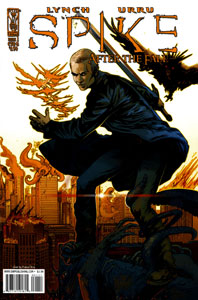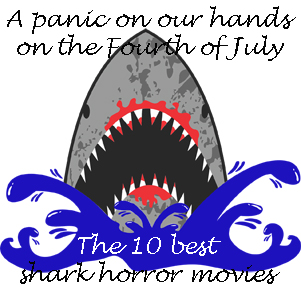“Spike: After the Fall” (July-October 2008) caps a trilogy of “Spike” titles – following “Asylum” and “Shadow Puppets” – from writer Brian Lynch and artist Franco Urru, as Spike falls in with new allies in late Season 5 and post-Season 5 of “Angel.” However, the allies in “After the Fall” are different from Team Spike in the previous volumes; that group is in Las Vegas and is none the wiser about Los Angeles’ descent into a hell dimension.
While the four-issue “Spike: After the Fall” may seem secondary to the main title, it’s actually better than “Angel: After the Fall” Issues 9-14, the period when Urru shifts over to work on this series. I don’t think it’s a coincidence that Lynch seems to be treading water on those issues of “Angel,” biding his time until Urru can return to conclude the saga.
Lynch seems more engaged with “Spike” during this period, and Urru is a more exciting artist than the folks filling in on “Angel.” He’s comfortable breaking away from stacked square panels, using unorthodox panel shapes and having heroes overlap the frame’s edges. Yet the readers’ eyes still follow progression with ease.
“Spike: After the Fall” tidily answers all the questions we had upon Spike’s introduction in “Angel: After the Fall,” where he is the Lord of Beverly Hills, with Illyria at his side, part of a pipeline with Connor for getting people to safety, and leader of a group of warrior women. The villain Non, a sexy demon-woman with knobby spikes along her arms, is an excellent centering device for these four issues. She gains her power by absorbing the life forces of nearby humans, who are left as husks.
Readers were learning about Illyria’s situation over on the “Angel” title at this time, and Lynch incorporates her inner conflict nicely here: The ancient goddess desires the warm relationship Fred had with Spike and her other friends, so she often morphs into an image of Fred. But when she does that, it weakens her powers. So Spike encourages her to not mimic Fred, and embrace the fact that she’s Illyria – but not too much. (We see the results of “too much” in the climax of “Angel: After the Fall.”)
Illyria’s pivotal action of killing Jeremy, Spike’s lieutenant of sorts who had become a friend (whether Spike admits it out loud or not, or whether he even calls him by the right name), robs Non of a chance to recharge and allows Spike to finish her. It’s the practical decision, the Illyria decision, but one she will struggle with going forward as she decides what type of being she wants to be.
Non had used a magic-using second-in-command to brainwash her army of demon-women into doing her bidding. Freed from this, they join Spike. “Spike: After the Fall” zeroes in on Spider, who we know becomes Spike’s love interest on the “Angel” title. Spider fights the brainwashing slightly better than her colleagues. She basically finds Spike to be hot, and the feeling is mutual. There’s not much to say about Spider beyond that, although the arachnid legs that sprout from her back in battle are cool.
Gunn makes a cameo that doesn’t affect the narrative much, and Connor hooks up with Spike late in the game as they establish their setup: Spike doesn’t want any humans in his Beverly Hills encampment, what with the unpredictable Illyria being there, but he will help Connor on missions to rescue humans and shepherd them to safety at Connor’s outpost. And thus we’re caught up with the start of “Angel: After the Fall.”
If you were already hooked by the previous Lynch/Urru “Spike” team-ups, this is another good one. It loses some surprise value by being a prequel to “Angel: After the Fall” (the start of which most fans had already read) but it makes up for that with the fun factor of seeing how things link up. I kind of miss Spike’s friends from “Asylum” and “Shadow Puppets,” but maybe we’ll see them again in post-“After the Fall” stories; it could be fun to see how they react upon meeting Illyria and Spider.
Click here for an index of all of John’s “Buffy” and “Angel” reviews.


